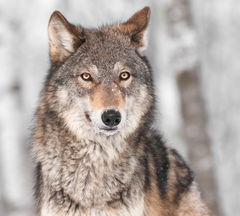
Wolves, with their fascinating behaviors, have captivated humans for a long time. Among the diverse species of wolves, grey wolves and white wolves are often cited as the most intriguing creatures. Each possess distinctive characteristics, shaped by their environments and evolutionary history. In this blog post, we explore the interesting realms of the grey wolf and the white wolf, unraveling their unique behaviors, and exploring the subtle differences that make them different from one another. If you’re as intrigued by wolves as we are, read on!
What is Unique about a Grey Wolf? Grey wolves, scientifically known as Canis lupus, are commonly referred to as timber wolves and are renowned for their intelligence, resilience, and complex social structures. Here are some interesting characteristics of grey wolves:

Adaptability: Grey wolves are highly adaptable predators that can thrive in various ecosystems and habitats, including forests, grasslands, and tundra regions. Their adaptability is a testament to their extraordinary versatility and ability to thrive regardless of the environment around them.
Group Behavior: Grey wolves live in complex social structures, living in packs led by an alpha pair consisting of a dominant male and a dominant female. Within the pack, the grey wolves establish hierarchies through complex dominance displays and submissive behaviors, fostering a sense of teamwork and unity, which are essential for survival.
 Communication: Grey wolves use a diverse repertoire of vocalizations, body language, and scent marking to convey information and maintain social cohesion. Their iconic howls serve as a means of long-distance communication, allowing them to locate pack members, delineate territory boundaries, and coordinate group activities. In this way, communication between grey wolves serves as a necessary tool for pack survival.
Communication: Grey wolves use a diverse repertoire of vocalizations, body language, and scent marking to convey information and maintain social cohesion. Their iconic howls serve as a means of long-distance communication, allowing them to locate pack members, delineate territory boundaries, and coordinate group activities. In this way, communication between grey wolves serves as a necessary tool for pack survival.
Keystone Species: As a keystone species, like elephants and bees, other species in the ecosystem depend on grey wolves. As apex predators, grey wolves play a pivotal role in maintaining the balance of ecosystems between predator and prey. They regulate prey populations and influence habitat dynamics, which has a significant influence on biodiversity and ecosystem health.
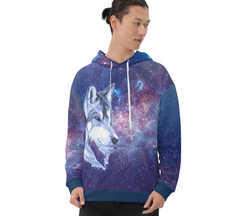
Do you love grey wolves? Check out our Wolf Lover Hoodies! Our Men's Blue Galaxy Wolf Hoodie is a favourite!
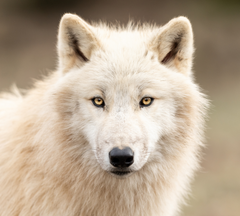
What is Interesting About a White Wolf? White wolves, which are also known as Arctic wolves or polar wolves, possess a mesmerizing beauty. Their pristine white coats are iconic and they have genetic adaptations which allow them to thrive in harsh Arctic environments. Here are some interesting qualities of white wolves:
Camouflage: The white coat of Arctic wolves is the perfect camouflage in their snowy surroundings, allowing them to blend seamlessly into the Arctic landscape and stalk prey with stealth and precision. This genetic adaptation enables white wolves to remain concealed from potential predators while enhancing their success when hunting.

Arctic Adaptations: White wolves have evolved a suite of genetic adaptations to cope with the extreme cold and harsh conditions of the Arctic. These adaptations include dense fur coats with insulating underfur, compact bodies to minimize heat loss, and small, rounded ears to reduce frostbite risk. All of these adaptations enable the white wolf to thrive in one of the world's most unforgiving environments.
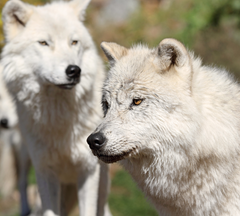
Specialized Diet: While grey wolves primarily prey on large animals such as deer and moose, white wolves have adapted to the availability of smaller prey species that are more common in Arctic conditions. Their diet may include Arctic hares, muskoxen, caribou, and other cold-adapted prey species, reflecting their ability to exploit diverse food sources in their environment.

Isolation in the Arctic: White wolves inhabit remote Arctic regions, experiencing isolation from human disturbances, as compared to their grey wolf counterparts, who often inhabit more populated areas. This isolation contributes to the preservation of their pristine habitats and distinct behaviors, allowing them to retain their primal nature in a vast and untouched wilderness.
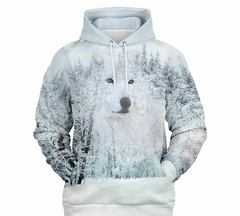 Do you love White Wolves as much as we do? Check out our Women's White Wolf Hoodie
Do you love White Wolves as much as we do? Check out our Women's White Wolf Hoodie
How are Grey and White Wolves Different from Each Other? While grey wolves and white wolves share many characteristics as members of the same species, there are notable differences between them that reflect their distinct evolutionary paths and ecological niches.

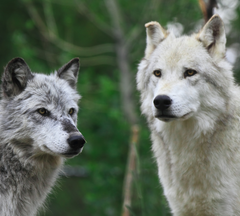
Physical Appearance: The most striking difference between grey and white wolves is their coat coloration. Grey wolves can have a range of grey, brown, and black hues in their coats, while white wolves have predominantly white fur. Additionally, white wolves may have slightly smaller bodies and shorter limbs compared to their grey wolf counterparts.
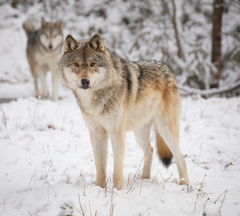
Habitat Preferences: Grey wolves are very adaptable and can be found in a wide range of habitats, including forests, grasslands, and tundra regions. In contrast, white wolves are suited to Arctic environments only, where they inhabit icy tundra, snow-covered landscapes, and coastal regions characterized by sea ice. Their distribution reflects their preference for cold climates and vast, open spaces devoid of human disturbance.
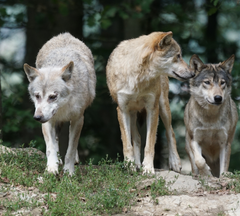
Prey Preferences: Grey wolves typically prey on larger animals such as deer, elk, and bison, utilizing cooperative hunting strategies to bring down formidable prey. In contrast, white wolves may target smaller prey species that are better adapted to Arctic conditions, including Arctic hares, muskoxen, caribou, and even marine mammals such as seals and belugas. Their diverse diet reflects the availability of prey in their Arctic habitat and the challenges of hunting in a resource-limited environment.

Behavioral Adaptations: While both grey and white wolves exhibit complex social structures and communication behaviors, their specific behaviors may vary based on their habitat and ecological constraints. Grey wolves, living in more varied landscapes, may demonstrate greater flexibility in their social dynamics and hunting strategies, while white wolves, adapted to the extreme conditions of the Arctic, may exhibit specialized behaviors optimized for survival in their harsh environment. Additionally, white wolves may display more solitary hunting behaviors due to the scarcity of prey and the vastness of their Arctic territories.
In conclusion, the Grey Wolf and the White Wolf epitomize the diversity and resilience of their species, each uniquely adapted to thrive in its respective habitat. While grey wolves showcase adaptability and social complexity across a range of ecosystems, white wolves are impressive with their Arctic adaptations and stunning camouflage. By unraveling the mysteries of grey and white wolves and exploring the differences that set them apart, we can appreciate these magnificent predators and the vital roles they play in shaping ecosystems around the world. From the sprawling forests of North America to the frozen expanses of the Arctic, the captivating presence of grey and white wolves reminds us of the enduring bond between humans and the natural world—a bond steeped in wonder, respect, and awe.

